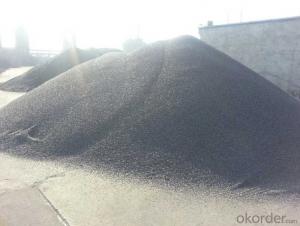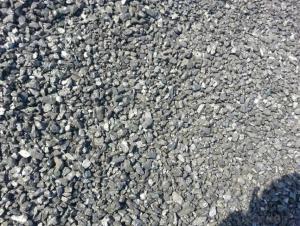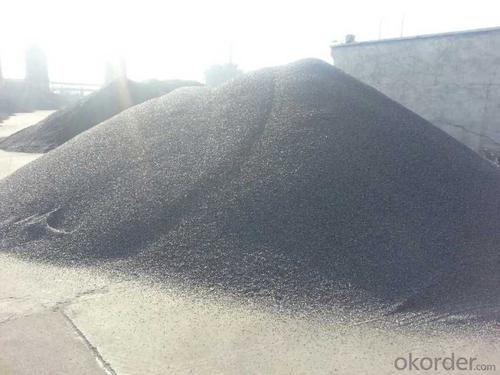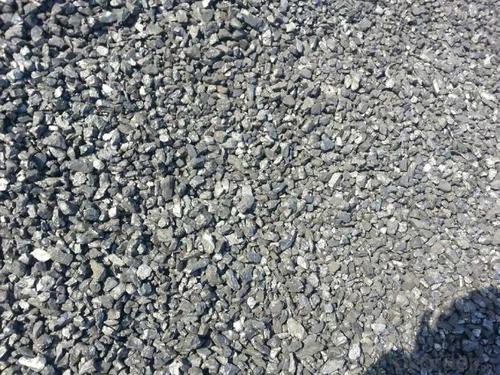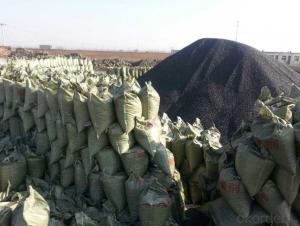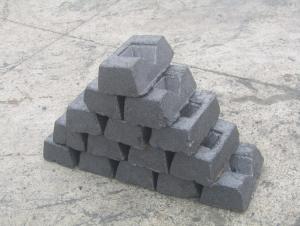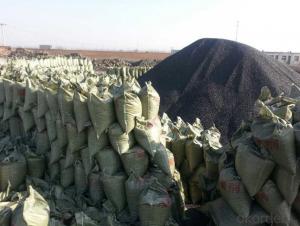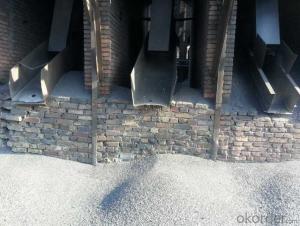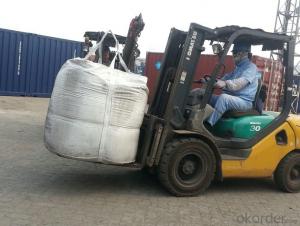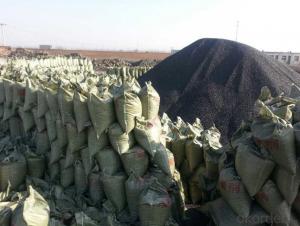Charge Coke FC90-95 with stable quality
- Loading Port:
- Tianjin
- Payment Terms:
- TT OR LC
- Min Order Qty:
- 20 m.t.
- Supply Capability:
- 3000 m.t./month
OKorder Service Pledge
OKorder Financial Service
You Might Also Like
Packaging & Delivery
25kgs/50kgs/1ton per bag or as buyer's request
Specifications
Calcined Anthracite
Fixed carbon: 90%-95%
S: 0.5% max
Size: 0-3. 3-5.3-15 or as request
It used the high quality anthracite as raw materials through high temperature calcined at over 2000 by the DC electric calciner with results in eliminating the moisture and volatile matter from anthracite efficiently, improving the density and the electric conductivity and strengthening the mechanical strength and anti-oxidation. It has good characteristics with low ash, low resistvity, low sulphur, high carbon and high density. It is the best material for high quality carbon products.
Advantage and competitive of caclined anthracite:
1. strong supply capability
2. fast transportation
3. lower and reasonable price for your reference
4.low sulphur, low ash
5.fixed carbon:95% -90%
6..sulphur:lower than 0.3%
General Specification of Calcined Anthracite:
| FC | 95 | 94 | 93 | 92 | 90 |
| ASH | 4 | 5 | 6 | 6.5 | 8.5 |
| V.M. | 1 | 1 | 1 | 1.5 | 1.5 |
| S | 0.3 | 0.3 | 0.3 | 0.35 | 0.35 |
| MOISTURE | 0.5 | 0.5 | 0.5 | 0.5 | 0.5 |
Pictures

We are also strong at below materials, please contact us if you are interested in any of them:
Calcined Petroleum Coke
Carbon Electrode Paste
Carbon Electrode
- Q: Process for producing carbon fiber board
- What is the production process of carbon fiber?For the production process of carbon fiber, when the PAN based carbon fiber is produced, the polyacrylonitrile fiber, which is called the parent fiber, is firstly prepared by polymerization and spinning process. These are then placed in an oxidizing furnace and oxidized at 200 to 300 degrees celsius. In addition, carbon fibers are also carbonized in the carbonization furnace at temperatures between 1000 and 2000 degrees celsius. In addition to the conventional type of fine carbon fiber, the PAN based carbon fiber also includes coarse fiber, known as the "tow man type carbon fiber", which costs less to produce the crude fiber.If you can not understand that there are other carbon fiber net professional look, introduce a carbon fiber network via Wuxi to see you, the above information and pictures very much, I often go to their website to learn.
- Q: What are the effects of carbon emissions on the stability of volcanic regions?
- Carbon emissions can have both direct and indirect effects on the stability of volcanic regions. Firstly, the direct effects of carbon emissions on volcanic regions are relatively minimal. Carbon dioxide (CO2) is a naturally occurring gas that is released during volcanic eruptions, so the additional carbon emissions from human activities may not significantly impact the stability of volcanic regions on their own. However, increased levels of carbon dioxide in the atmosphere can contribute to climate change, which in turn can indirectly affect volcanic activity. Indirectly, climate change resulting from carbon emissions can have several effects on the stability of volcanic regions. Rising global temperatures can cause the melting of glaciers and ice caps, leading to an increase in the amount of water on the Earth's surface. This can add extra weight to volcanic areas, potentially increasing the pressure on magma chambers and triggering volcanic activity. Additionally, the increased water levels can contribute to higher levels of rainfall, which can increase the risk of landslides and erosion in volcanic regions, potentially destabilizing the area. Furthermore, climate change can also lead to changes in precipitation patterns and drought conditions, altering the hydrological cycle. These changes can impact the availability of water for volcanic regions, affecting the stability of volcanic systems. Volcanoes require water to produce steam and pressure that can lead to eruptions. If there is a lack of water due to prolonged drought conditions, volcanic activity may be reduced. However, when there is an excess of water due to unpredictable rainfall patterns, there is an increased risk of flash floods and landslides, which can destabilize volcanic areas. It is important to note that the effects of carbon emissions on the stability of volcanic regions are complex and can vary depending on a range of factors such as local geology, volcanic activity, and climate conditions. While carbon emissions may not directly cause volcanic eruptions, they can contribute to changes in climate patterns that can indirectly impact the stability of volcanic systems. Further research and monitoring are essential to fully understand and quantify these effects.
- Q: How does carbon affect the formation of acidification in lakes?
- Carbon dioxide (CO2) plays a significant role in the formation of acidification in lakes. When carbon dioxide is released into the atmosphere through various human activities, such as burning fossil fuels, it can be absorbed by water bodies like lakes. This absorption leads to the formation of carbonic acid (H2CO3), a weak acid. Carbonic acid dissociates into hydrogen ions (H+) and bicarbonate ions (HCO3-) in water. The increase in hydrogen ions causes a decrease in pH levels, making the water more acidic. This process is known as acidification. Acidification in lakes can have detrimental effects on aquatic ecosystems. It affects the physiology and behavior of many species, including fish, amphibians, and invertebrates. Acidic waters can also damage the eggs and larvae of these organisms, hindering their growth and survival. Additionally, acidification can alter the composition and abundance of phytoplankton, which are crucial for the overall health of the ecosystem. High levels of acidity can also lead to the leaching of toxic metals, such as aluminum, from the surrounding soil and rocks. These toxic metals are then dissolved in the water, posing an additional threat to aquatic organisms. Acidification can also disrupt the nutrient cycles in lakes, affecting the availability of essential nutrients for plants and animals. In summary, the presence of carbon dioxide in the atmosphere contributes to the acidification of lakes when it is absorbed by water. This acidification has a range of negative impacts on the aquatic ecosystem, including altered physiology, impaired reproduction, and disrupted nutrient cycles. It is crucial to reduce carbon emissions and mitigate the effects of acidification to protect the health and diversity of lake ecosystems.
- Q: What are the consequences of increased carbon emissions on forest ecosystems?
- Increased carbon emissions have significant consequences on forest ecosystems. One of the most notable impacts is the alteration of the climate and weather patterns. The excessive carbon dioxide in the atmosphere traps heat, leading to global warming. This rise in temperature can disrupt the delicate balance of forest ecosystems. Warmer temperatures can cause shifts in the distribution and composition of tree species, as some may struggle to adapt to the changing conditions. Another consequence of increased carbon emissions is the acidification of rainwater. When carbon dioxide combines with water vapor, it forms carbonic acid, which can fall as acid rain. Acid rain has detrimental effects on forest ecosystems, as it leaches important nutrients from the soil and damages tree leaves and other vegetation. This can weaken the overall health of the forest and make them more susceptible to diseases and pests. Furthermore, increased carbon emissions contribute to the intensification of wildfires. Higher temperatures and drier conditions provide the perfect environment for fires to spread and become more frequent. Forests that have evolved to withstand natural fire regimes may struggle to cope with the increased intensity and frequency of these fires. This can lead to the loss of biodiversity, destruction of habitat, and long-term degradation of forest ecosystems. Lastly, increased carbon emissions contribute to the phenomenon known as ocean acidification, where excess carbon dioxide is absorbed by the oceans. This acidification can affect the health of coastal and marine ecosystems, which are intricately connected to forest ecosystems. Many forest ecosystems, such as mangroves and salt marshes, provide vital nursery habitats for marine species. If these forest ecosystems decline due to carbon emissions, it can have cascading effects on the health and productivity of coastal and marine ecosystems. Overall, increased carbon emissions have far-reaching consequences on forest ecosystems. It alters climate patterns, causes acid rain, intensifies wildfires, and affects coastal and marine ecosystems. These impacts not only harm the trees and vegetation within the forests but also disrupt the delicate balance of the entire ecosystem, leading to loss of biodiversity and long-term degradation. It is crucial to mitigate carbon emissions and promote sustainable practices to minimize these consequences and preserve the health and integrity of forest ecosystems.
- Q: How do you remove car carbon?
- 3, running high speed can flush carbon deposition? Running high speed, you can really use the airflow on the airway erosion, wash away part of the carbon deposition. So, if you happen to go out, there are high-speed, national road two choices, you may choose to pull back to speed. But, Ma director thinks, if be in order to "flush carbon deposit" specially, want to run high speed, do not have this necessity. "It is a waste of time, and the cost of oil, extra high speed tolls, the effect is better to do a maintenance 4S shop!" 4, improve the shift speed, such as the original speed 2000rpm shift, modified 2500rpm conversion, generated can prevent carbon deposition, but also to protect the engine? Ma director said, low speed the shift, is often said that the "drag block", the car is easy to knock, the combustion of gasoline is not sufficient to carbon deposition. But it's not necessary for people to increase gear speed - that will increase fuel consumption and cause premature wear of clutch friction plates. So, manual transmission of the car, 1.6 ~ 2.0L displacement, about 2000 rpm shift is more economical, and no need to improve; and automatic car, pay attention not to slam the gas.
- Q: How is carbon used in the production of adhesives?
- Adhesives make use of carbon in various ways during production. One way is by utilizing carbon black, a fine powder created from the incomplete combustion of hydrocarbon fuels. Adding carbon black to adhesives improves their strength, durability, and resistance to UV radiation. It acts as a reinforcing agent, enhancing the adhesive's adhesion and cohesion properties. Furthermore, adhesives sometimes incorporate carbon fibers to further enhance their strength and mechanical properties. These fibers are produced by heating and stretching synthetic fibers or natural materials like rayon or petroleum pitch. Including carbon fibers in adhesives increases their tensile strength and stiffness, making them ideal for high-performance applications. Additionally, carbon-based polymers like epoxies and polyesters find wide use in adhesive formulations. These polymers are created through chemical reactions involving carbon-based monomers. They offer excellent bonding properties, high resistance to heat and chemicals, and can be customized to meet specific application requirements. Moreover, carbon-based resins can be modified with other additives and fillers to achieve specific characteristics, such as flexibility, impact resistance, or flame retardancy. In conclusion, adhesives benefit from the incorporation of carbon black, carbon fibers, and carbon-based polymers. These materials significantly enhance the strength, durability, and other properties of adhesives, making them suitable for a wide range of applications in industries such as automotive, construction, electronics, and aerospace.
- Q: A carbon Roast Lamb Leg stores need to how much money
- You buy yourself a Roasted Whole Lamb furnace, generally in the 2600-3000 Roasted Whole Lamb Roast Lamb Leg can fix, baking method will provide. Can buy Roasted Whole Lamb furnace Ji'nan Thebaud Hardware Products Co. Ltd.
- Q: What are the carbon monoxide collection methods?
- Drainage method.Because the density of carbon monoxide is almost the same as the density of air, it is difficult to obtain pure carbon monoxide by exhaust air.
- Q: Search for a summary of the importance of carbon in life. If you write well, you can add points,
- Carbon is a nonmetallic element, whether it is carbon of single substance or carbon compound. It plays an indispensable role in material production, daily life and human existenceThe material containing carbon elemental state are mainly coal, charcoal, graphite and diamond; coal, charcoal is agent or reducing domestic and industrial fuel, raw materials, graphite pencil electrode materials and high temperature resistant materials, diamond is expensive jewelry materials and industrial superhard materials.
- Q: What are the economic impacts of carbon emissions?
- The economic impacts of carbon emissions are significant and wide-ranging. Carbon emissions contribute to climate change, leading to more frequent and severe extreme weather events such as hurricanes, droughts, and heatwaves. These events can result in extensive property damage, loss of agricultural productivity, and increased healthcare costs. Furthermore, carbon emissions contribute to air pollution, which has detrimental effects on human health and productivity. Increased healthcare expenditures, decreased workforce productivity, and higher mortality rates are some of the negative economic consequences associated with air pollution caused by carbon emissions. Additionally, industries that heavily rely on fossil fuels, such as coal and oil, may face economic challenges as governments and consumers increasingly demand cleaner and more sustainable alternatives. This transition towards a low-carbon economy may lead to job losses in carbon-intensive sectors and require significant investments in new technologies and infrastructure. On the other hand, reducing carbon emissions can also create economic opportunities. The growth of renewable energy industries, such as solar and wind power, can create new jobs and foster innovation. Moreover, investing in energy-efficient technologies and practices can lead to cost savings for businesses and households. In summary, the economic impacts of carbon emissions encompass both negative consequences, such as climate-related damages and health costs, as well as potential positive outcomes, including job creation and cost savings through clean energy and efficiency measures. Addressing carbon emissions is crucial for sustainable economic development and long-term prosperity.
Send your message to us
Charge Coke FC90-95 with stable quality
- Loading Port:
- Tianjin
- Payment Terms:
- TT OR LC
- Min Order Qty:
- 20 m.t.
- Supply Capability:
- 3000 m.t./month
OKorder Service Pledge
OKorder Financial Service
Similar products
Hot products
Hot Searches
Related keywords
